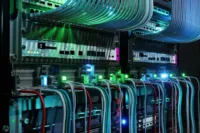
Fiber optic cables are one of the most advanced and popular forms of network cabling, used in a variety of applications ranging from telecommunications systems to cable television networks. This type of cabling utilizes glass or plastic fibers to transmit data over long distances using pulses of light instead of electrical signals. In this blog post, we will discuss what fiber optic cables are, their various types and advantages, and some common applications.
What is a Fiber Optic Cable?
Fiber optic cable is made up of strands of optically pure glass that are surrounded by protective layers such as plastics and metals. The core is where the light travels through, while the cladding reflects the light back into the core. The outside layers protect the inner components from damage and provide mechanical strength. This type of cable is capable of transmitting large amounts of data over long distances with minimal signal loss due to its low attenuation properties.
Types of Fiber Optic Cables
Fiber optic cables come in two varieties: multimode fiber optic cables (MMF) and single-mode fiber optic cables (SMF). MMF is typically used for shorter distances—up to 2km—and can carry many different signals at once, making it ideal for networking within a building or campus environment. SMF is designed for longer distances—at least 10km—and carries only one signal at a time, making it better suited for connecting two locations that are far apart.
Advantages of Using Fiber Optics Over Traditional Networking Methods
There are several benefits to using fiber optics over traditional copper wiring or other wireless technologies: increased bandwidth capacity, longer distance capability, improved reliability and security, and reduced electromagnetic interference (EMI). Fiber optics allow much more data to be transmitted than copper wires due to its higher bandwidth capacity; it can also transmit data over much longer distances without signal degradation than other methods due to its low attenuation rate; it has improved reliability because it is less susceptible to environmental factors such as temperature changes or moisture; and finally, it offers improved security because it does not emit any radiation like other wireless technologies do.
Applications of Fiber Optics in Modern Technology
Applications for fiber optics have grown substantially since its earliest days when it was primarily used in telephone lines and medical equipment. Nowadays, they are used extensively in telecommunications systems such as cellular phones and internet connections; they can be found in cable television networks as well; they are even being used in automotive safety systems such as lane departure warning systems; they have even been adapted for use underwater! It’s clear that fiber optics play an integral role in modern technology today – so much so that some people refer to them as “the nervous system” that connects us all together!
It’s easy to see why fiber optics have become so popular in recent years – their low attenuation rate makes them ideal for transmitting large amounts of data over long distances with minimal signal loss; their ability to resist environmental factors makes them reliable; their lack of radiation makes them secure; and their versatility means they can be adapted for use in almost any application imaginable! Whether you’re looking for faster speeds on your home network or needing a reliable connection between two remote locations – fiber optics offer an array of benefits that make them an attractive option no matter what your needs may be. With all these advantages combined with their affordability, it’s no wonder fiber optics have become such a popular choice among businesses today!











